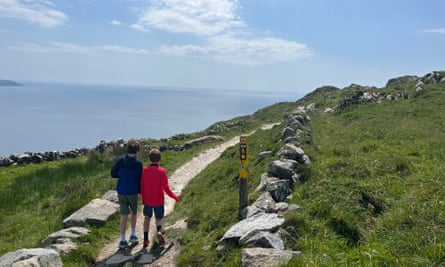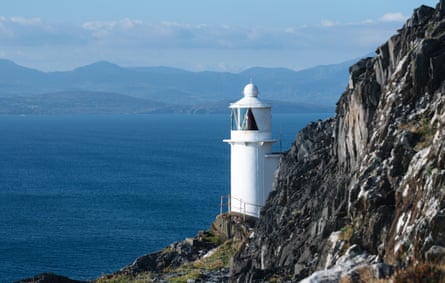At first, there is some fussing from my 10- and 12-year-old sons. “Will the water be too cold?”, “I don’t want to wear a wetsuit”, “Are there even any decent waves?”… But once their young surf instructor, Josh Mahony, appears with two boards under his arms and the kind of shoulders that suggest he could paddle south to Spain and back in his lunch break, there is only silence as they follow him into the waves.
Some hours later, having caught many waves including their first proper unbroken green ones – before today they’d only surfed more easily managed whitewater – it’s an effort to get them out.

We’ve come to Garretstown in County Cork, a picturesque stretch of sandy beach dotted with smooth grey, brown and smooth purple pebbles. In the car park, an old man is selling honey, eggs and swedes from a picnic table, while all around us is verdant green countryside and cows, save a brutalist concrete toilet block, a yellow airstream pizza van and a wooden sauna sitting above the shoreline.
The boys are having a lesson with Atlantic Offshore Adventures (€30), and I rent a board to join them. The water is incredibly clear and rich in seaweed – signs of a healthy marine ecosystem. There was uproar in spring when Garretstown lost its Blue Flag clean beach status for not having the right recycling bin, but that’s since been rectified and the award reinstated.

The waves are small, clean and lovely – we even catch a few “party waves” riding in altogether – and as there are big gaps between each set, we get to ask Josh what it was like to grow up here. “Everyone is very sporty and outdoors loving,” he says. “I played rugby, hurling and Gaelic football, and also did cross-country, swimming, surfing and windsurfing.”
He tells us the waves aren’t always as smooth as they are today, but this beach is generally good for beginners, as even when it’s ruined by the wind there is usually whitewater to surf. And if it is flat, they offer standup paddleboarding at a nearby beach.
After our surf, we head to nearby Garrylucas Beach, a popular sea swimming spot and enjoy pizza at Stranded, a cafe, tapas and wine bar that often has indie folk bands playing.
Garretstown sits on the Wild Atlantic Way, a 1,600-mile coastal route that runs from the Inishowen peninsula in Donegal to the village of Kinsale eight miles up the road. We spend the night slightly inland amid lush green fields at Rivermount House (doubles from €95 B&B), a peaceful place with scenic views of the Bandon River. The next day we follow the route west, stopping off at Clonakilty Adventure Centre, which has a fun high ropes course and zip wire, before heading to the Sheep’s Head peninsula, and its network of 125 miles of coastal hiking trails.

We decide to hike the Lighthouse Loop, a three-mile route that circles the tip of the peninsula. With its dramatic sea cliffs, steep rocky paths, remote lake and lighthouse, it evokes an edge-of-the-world feel that the boys relish.. That night, we base ourselves in the harbour town of Bantry, staying at the Maritime Hotel (doubles from €104) and feasting on very good pizza at the Brick Oven.
The next morning, we wake early and continue on the Wild Atlantic Way for a sunrise kayak at Glengarriff Bay in the Beara peninsula, between the low Caha mountains and the sea, with Nathan Kingerlee from Outdoors Ireland. The bay is misty, still and empty, and the boys are wide-eyed as Nathan points out more wildlife in a couple of hours than they’ve seen in their lives: harbour seals, a white-tailed eagle, oystercatchers, curlews, grey heron and moon jellyfish. We even spot a mute swan taking her cygnets for a swim by the scruff of their necks, something Nathan says he’s never seen in 18 years of guiding.

Our arms are aching by the time we’ve finished our kayaking in the bay, so we head to the Eccles Hotel on the waterfront, once a favourite with Victorian aristocrats, for breakfast and the boys power up on smoothies and waffles, while I enjoy the veggie breakfast option, which includes spinach, fennel and potatoes with eggs.
In the afternoon, we join a folklore e-bike tour (€49 adult/€39 child, including bike hire), which starts at the colourful fishing village of Union Hall. The 12-mile ride, through rolling hills and ancient Atlantic woodland, with sweeping views of the coastline, has just the right ratio of adrenaline and adventure to enthuse the boys.
after newsletter promotion
Our guide, Conor Ó Buachalla, a local history expert, is full of enchanting folklore stories and darker tales about the O’Donovan clan, the ruling clan of the area from whom he’s descended, including stories about heads found buried in the sand and mothers thrown down wells, which the boys lap up.

“My stories are mostly true but 100% authentic,” he says with a smile. But Conor is also good at putting it all in context. This part of West Cork has suffered a lot over the years; at South Reen, three miles south of Union Hall, he shows us where one of the first recorded deaths from starvation in the Great Famine (1846-1851) was said to have occurred. He also points out fields scarred where potato plants were abandoned. As an English person, albeit one with some Irish origin, it’s hard not to feel a sense of ancestral guilt.
The famine, which kickstarted a chain of emigration, caused the population to crash by 80% in some districts, but it has been modestly recovering since the 1950s, helped by small-scale fishing ,now itself under threat from dwindling stocks due to industrial trawling, says Conor.
Some areas of West Cork didn’t get electricity until the early 1960s, so perhaps it’s not a surprise that folklore and storytelling thrived as a way to while away the dark nights and long winters and escape the everyday. “This is the landscape of a people who were very poor materially and suffered a lot of trauma, but they were rich in storytelling, music and sport,” says Conor.

After our ride, we stop by Union Hall’s well-tended Gaelic football pitch and end up having a kickabout in one of the goals as the sun slips down behind the high trees that surround us.
When I’d asked Josh, the boys’ surf instructor, whether getting kids outdoors and off screens was a big problem in West Cork in the way it is back home in south-east England, he’d looked a bit baffled at the question, which makes sense to me now given how much there is to do here. We’ve barely sat down or glanced at a screen our whole trip, and none of us would have it any other way.
Accommodation and trips were provided by Tourism Ireland

